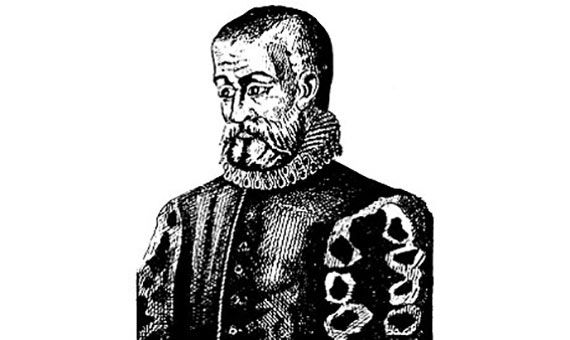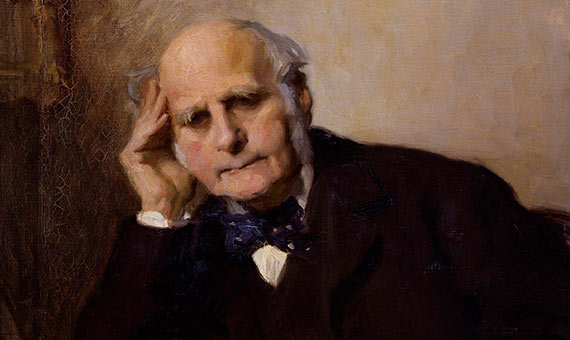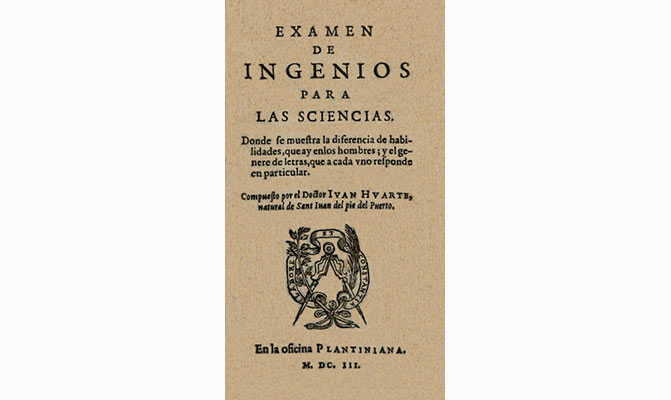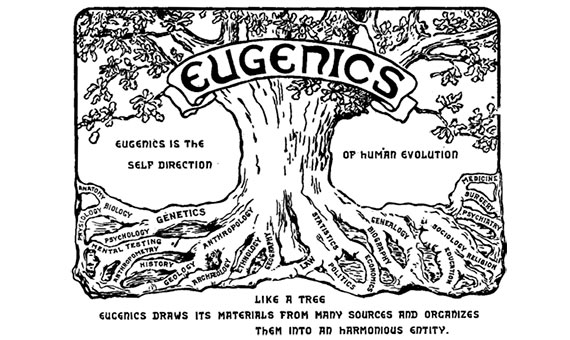Ramón y Cajal, the Spanish doctor with the greatest impact both in Spain and abroad, is followed in importance by the Golden Age physician and philosopher, Juan Huarte de San Juan (1529-88). His only work, The Examination of Men’s Wits, published in 1575 but subsequently widely re-edited and translated into as many as seven different languages, has influenced numerous leading writers from Miguel de Cervantes to the philosopher and politologist Noam Chomsky. Above all, his work has served as the basis for the birth of several fields of knowledge such as psychology, neuropsychology, pedagogy, professional orientation, sociology and linguistics, and even eugenics.

Although the validity and relevance of Huarte’s work has been the subject of frequent analysis, less attention has been paid to his ideas on eugenics regarding “the way in which parents should engender children” to ensure above all that they should be “clever and wise”. What are these ideas and how are they viewed today?
The peculiar (unusual) eugenics of Huarte
Eugenics, understood as the “science of the possible improvement of mankind”, emerged in the late 19th century based on the works of Darwin’s cousin, Francis Galton. Ensuring that our children fulfill their maximum physical and mental potential is a question that has always concerned mankind, and has been discussed by such eminent authors as Aristotle, Hippocrates and Galen. Based on these authors and contributing his own ideas, in the last part of his work (published over three centuries before Francis Galton‘s own work), Juan de Huarte analyzes what he considers to be the four fundamental aspects of any theory of eugenics.
First, he maintains that to make the most suitable marriages, women –and particularly men– should consider several characteristics in their potential partners: intelligence and ability, their habits and condition, voice, color, hirsuteness and attractiveness or ugliness. And to ensure that marriages are fertile, Huarte recommends different combinations of partners depending on the degree to which these characteristics are present. So, for example, he says that “the woman who has these characteristics to an average degree, except for beauty to a maximum degree, can be fertile and bear children with almost all men”.

In second place, Huarte explains what he considers to be the technique for producing male rather than female offspring, as in keeping with the ideas of his time, he believed women’s intelligence (today we would say mental capacity) to be inferior to men’s. On this point, Huarte believes that it is the “seed” of the right testicle that originates males and that of the left that gives rise to females, and also proposes a series of measures to procreate males: eating hot dry foods, doing abundant exercise and making sure the “male seed” falls on the right side of the uterus.
After establishing these two aspects, he then gives some recommendations to ensure that children are born wise and not “silly”. He continues to set great store by the type and amount of food consumed, and differentiates between foods that should be eaten in the case of wishing to produce children with a good memory, good imagination or good understanding, which are the three qualities that he believes constitute intelligence. His advice also includes drinking water that is “delicate, sweet and of good temperament”, and protecting oneself from southerly winds at the time of procreation.
Finally, in order to raise children to preserve their intelligence once they have been born, in addition to offering recipes on how to care for them after birth, he recommends that they should be taught good eating and drinking habits, and maintains that they should not be given an “easy” life (for example, he advises against soft beds, abundant clothing and too much to eat). In terms of their intellectual education, each child should be guided according to his or her intelligence: those with a good memory should be encouraged to study law, those with a lively imagination should be directed to practical medicine, and those who are born with superior understanding should study theology, etc.
Positive and negative eugenics. Huarte’s ideas in the present day
Many of the biological bases of Huarte’s ideas are today obsolete. For example, we no longer refer to the different role of the two testicles in determining sex, but to the X and Y chromosomes contained in sperm cells. Nor do we believe that the right part of the uterus is different from the left. However, he is right in rejecting the role of “imagination” in heredity. Huarte argues that those who believe that what a woman or a man is thinking at the time of procreation can determine certain characteristics in their descendants “know little of natural philosophy”. And above all, although at times he contradicts himself, he defends the possibility that women can contribute with their “seed” to the following generation. Until then the prevailing idea was that only the male supplied the seed needed for procreation, and that the woman was merely the “soil” on which it is sown.

If we look closely at his ideas on eugenics, most can be framed within what today would be classified as positive eugenics. Since the emergence of this field as a science in the early 20th century, a series of measures have been implemented, ranging from sterilization through to prenatal detection of disorders in embryos and embryo selection to reject serious malformations and diseases. This is what is known as negative eugenics.
But other measures have also been proposed that can be classified as positive eugenics and are aimed at favoring reproduction and survival. The creation of sperm banks from Nobel prize winners and illustrious men –and even cloning– are examples of this approach. Also in regard to this type of eugenics, within the revolutionary technique of CRISPR-CAS there is currently talk of the possibility of radically improving the human species both physically and mentally by introducing favorable genetic variants, even in apparently normative genomes. Naturally, all this raises numerous biological, legal and ethical questions.

Most of Huarte’s ideas on eugenics can on the whole be framed within the field of positive eugenics, as they address the issue of how to produce good and wise children, and do not exclude as progenitors even those who were supposedly not ideal candidates. In fact, he mentions that it is possible for couples who are not particularly “intelligent” to engender “wise” children.
However, according to what we know today, his dietary advice would not have much success for specifically eugenic purposes.
The Examination of Men’s Wits can be read in the Cervantes Virtual Library and the most recent and comprehensive edition on paper dates from 1989 by Guillermo Serés in Catedra-Letras Hispanas, issue 311.
Comments on this publication